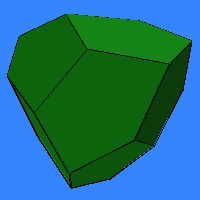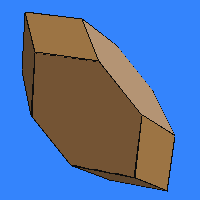Dodecahedra
No hard decode. And in this case,
A solid answer you can claim.
It has (I'm told) a different face
for every letter of its name.
--Hubert Phillips*

There are a great many 12-sided polyhedra, all of which could be called
dodecahedra.
This page lists a number of the more important examples and their differences,
organized according to what type of faces are present. At right is what
minerologists call a tetartoid.
It is topologically equivalent to the regular dodecahedron (as it has twelve
identical 5-sided faces, meeting three to a vertex) but the faces are irregular
pentagons, and the overall symmetry is
tetrahedral and chiral.
Regular Pentagons
Regular Pentagrams
Irregular Pentagons
-
The pyritohedron comprises twelve identical
irregular pentagons. Each pentagon has mirror symmetry and the solid as
a whole has tetrahedral symmetry (four 3-fold axes and three 2-fold axes)
with three mirror planes. It is commonly given this name because the mineral
pyrite can appear in crystals of this shape.
So it is true that pentagonal dodecahedra are found in nature, but no mineral
crystals are regular pentagonal dodecahedra. These minerals may
have been an inspiration to the ancient Greeks who first wrote about the
regular dodecahedron, but they still made a significant leap in going from
the lesser symmetry of a pyritohedron to the greater symmetry of the regular
pentagonal dodecahedron. (In pyrite, the pentagons are in the "0-1-2 planes"
as crystallographers call it. An interesting relative, with slightly different
angles, is a pyritohedron which is
a stellation of the icosahedron, so the faces are in the planes of
twelve of the regular icosahedron's twenty faces.)
-
The tetartoid, shown at the top of this
page, is another pentagonal dodecahedron of crystallographic importance.
It is composed of twelve identical irregular pentagons, but has three different
types of vertices. It is also called the tetrahedral pentagonal dodecahedron
because of its chiral tetrahedral symmetry.
-
If you take a regular pentagon made of paper and fold it on any diagonal,
the five edges outline a concave pentagon. Twelve of these pentagons assemble
into a concave dodecahedron with pyrite
symmetry. This form is particularly interesting because if you alternate
it with regular dodecahedra you can pack space without gaps. (You
can easily make a very nice Zome model of the polyhedron and the packing,
as described in Zome Geometry.)
Regular Triangles
-
The snub disphenoid is the
only convex polyhedron composed of twelve equilateral triangles. It is
one of the eight regular convex deltathedra.
It was given that name by Norman Johnson because you can construct it by
separating a disphenoid into
two parts (of two faces each; sphenoid is Greek for wedge)
and then reconnecting them via a band of "snub" triangles. It was called
a Siamese dodecahedron in the paper by Freudenthal and Waerden which
first describes it.
Isosceles triangles
-
Many different "dodecahedra" are composed of twelve isosceles triangles.
The most important is probably the hexagonal
dipyramid, but one would never call it a dodecahedron since
that would obscure its important properties as a dipyramid.
-
Another is the triakis tetrahedron,
but it would also be odd to call it any kind of dodecahedron and
obscure the fact that it is an Archimedean
dual.
-
Here's a nice isosceles dodecahedron.
It comes from an infinite family which Joe Malkevitch showed me; it can
be extended to any number of isosceles faces that is divisible by four
if we make the faces pointy enough.
Scalene triangles
-
There are a great many different "dodecahedra" composed of twelve non-regular
triangles. One symmetric family is formed as follows: Pick three alternate
vertices on the "equator" of a hexagonal dypyramid, and move them in or
out slightly, by the same amount. The result is called a ditrigonal
dipyramid by crystallographers.
-
Another is called the hexagonal scalenohedron
by crystallographers. It is formed by moving three of the equatorial vertices
up and three down. Both of these these have one degree of freedom
in choosing the face shape. They are not of great interest to geometers,
but minerologists use the terms for certain crystal
forms.
Rhombi
-
The rhombic dodecahedron has
all the symmetry of a cube or octahedron. It is a zonohedron
and the Archimedean dual to the
quasi-regularcuboctahedron.
The ratio of the lengths of the two diagonals of each rhombus is the square
root of two.
-
The rhombic dodecahedron
of the second kind is another zonohedron, but with a different rhombus
shape, and it only has 2-fold prism symmetry (three mutually orthogonal
2-fold axes and three symmetry planes). The ratio of the lengths of the
two diagnals is the golden ratio (just like the rhombic
triacontahedron to which it is related by the zone
removal process.) Interestingly, both of these rhombic dodecahedra
are space fillers. (The origin of this polyhedron is unclear to me. Coxeter
[Regular Polytopes, p. 31] gives a 1960 reference for its first
publication, but I have observed that it appears as a pop-up paper model
in the 1787 Solid Geometry of John Lodge Cowley.)
Kites
-
The hexagonal trapezohedron
is the dual to the hexagonal
antiprism. It is called "hexagonal" because it is based on a
hexagon and has a 6-fold axis of symmetry. There are twelve "kite-shaped"
faces---tetragons with a diagonal mirror, sometimes called deltoids,
and called trapezoids in British English.
-
The trapezoidal dodecahedron
is a crystallographic polyhedron with twelve "kite-shaped" faces . It has
tetrahedral symmetry with six mirror planes, and can be derived from the
tetrahedron by dividing the triangles by thirds into kites and then puffing
it out a bit. It is topologically equivalent to the (first)
rhombic
dodecahedron above, and can be derived from that by stretching it in
four tetrahedral directions.
 More
than one type of face
More
than one type of face
-
The elongated dodecahedron,
illustrated at right, is like a rhombic
dodecahedron with four faces stretched (arbitrarily) into hexagons
and eight remaining rhombic. It is particularly interesting for being one
of only five solids which packs to fill space by translation alone.
-
The twisted rhombic dodecahedron
(or "trapezo-rhombic" dodecahedron) is related to the rhombic dodecahedron
by sawing it in half along a hexagonal equator and rotating one part a
sixth of a revolution relative to the other part. Along that equator, six
of its faces are trapezoids. It is also a space-filler. (Observe that just
as the rhombic dodecahedron
is dual to the cuboctahedron,
so this twisted rhombic dodecahedron is dual to the triangular
orthobicupola, which is like a cuboctahedron with one half twisted
a sixth of a revolution.)
-
Many other miscellaneous polyhedra happen to have twelve faces of various
sorts, though we don't normally refer to them as dodecahedra. Examples
are the decagonal prism, pentagonal
antiprism, pentagonal cupola,
elongated
square dipyramid, and metabidiminished
icosahedron. The last three of these are examples of Johnson
solids.
Irregular nonconvex faces
* The poem above is in some references incorrectly
attributed to Bishop Samuel "Soapy Sam" Wilberforce. Notice how the
anagram No hard decode is made from the twelve letters of dodecahedron.

 More
than one type of face
More
than one type of face